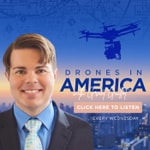Drones in America – Details, episodes & analysis
Podcast details
Technical and general information from the podcast's RSS feed.

Drones in America
MarketScale
Frequency: 1 episode/10d. Total Eps: 23

Drones in America is your go-to B2B drone podcast, presented by MarketScale. Your host, Grant Guillot, leads the unmanned aircraft systems practice team for the law firm of Adams & Reese. Every Wednesday, he chats with leaders, influencers, and experts who are impacting the rapidly growing commercial drone industry in the United States to help us through the complex web of technology and policy.
Recent rankings
Latest chart positions across Apple Podcasts and Spotify rankings.
Apple Podcasts
🇫🇷 France - businessNews
02/09/2024#85🇫🇷 France - businessNews
01/09/2024#80
Spotify
No recent rankings available
Shared links between episodes and podcasts
Links found in episode descriptions and other podcasts that share them.
See all- https://www.nasa.gov/
403 shares
- https://www.walmart.com/
86 shares
RSS feed quality and score
Technical evaluation of the podcast's RSS feed quality and structure.
See allScore global : 59%
Publication history
Monthly episode publishing history over the past years.
What 3 Trends Are Driving Q4 in the Drone Industry?
mercredi 7 octobre 2020 • Duration 30:28
3 Trends Driving the Drone Industry Right Now:
- Increased Hardware Competition Signals Market Shift
- Rising Global Tensions and Move Toward Dual-Use
- Improving Autonomy and Shifting Regulations
DroneUp Announces Partnership with Walmart to Deliver Covid Tests by Drone
vendredi 25 septembre 2020 • Duration 31:59
DroneUp just announced a partnership with Walmart and Quest Diagnostics to deliver at-home COVID-19 self-collection kits. Walmart has already been experimenting with with the practicality of drone delivery for select grocery and household essential items, but has not advanced past the trial stage. Delivering COVID-19 tests is not only a highly relevant need in our society, but would be a big step forward in analyzing the efficiency of drones in deliveries.
Why Leaders Need to Implement Drone Technology Now
Episode 13
jeudi 21 mai 2020 • Duration 29:05
In this week’s episode, Guillot is joined by Jeremiah Karpowicz, Editorial Director at Diversified Communications, a well-known and widely-respected journalist who regularly reports on the commercial drone industry.
The two discuss the importance of leadership in the industry, especially at a time when companies in various end-user sectors are striving to economically recover while implementing social distancing. Karpowicz sets forth his belief that company leaders who embrace drones in the near term, rather than delaying implementation of drone technology until after “things return to normal”, are more likely to rise above the economic devastation caused by the COVID-19 pandemic.
Karpowicz and Guillot also discuss the Commercial UAV Expo Americas, the world’s largest commercial UAS event, and the import role industry leaders and organizations, such as the Commercial Drone Alliance, play in facilitating the collaboration of government and industry to safely integrate drones into the National Airspace.
The two conclude their conversation by reflecting on how, despite the fears and uncertainties that have arisen due to COVID-19, the commercial drone industry can look forward to once again congregating in-person once it is safe to do so.
‘CSI’ Creator on How to Make Drones the Hero
Episode 12
jeudi 14 mai 2020 • Duration 33:00
In this week’s episode, Guillot is joined by Anthony E. Zuiker, the creator of the CSI franchise – the most successful television series of all time, as well by Tom Walker, Founder and CEO of DroneUp.
Guillot, Zuiker, and Walker discuss Zuiker’s interest in crime scene evidence and how he came to develop the original CSI and its three spinoffs.
Zuiker explains his decision to back in 2005 to have an unmanned small-helicopter device serve as the murder weapon in “The Dove Commission,” an episode in Season 1 of CSI: New York.
Guillot, Walker, and Zuiker discuss Zuiker’s decision to use drones to film the final scene of the original series, in which Jorga Fox’s Sara Sidle and William Petersen’s Gil Grissom sail off into the sunset.
Zuiker also discusses how drones are currently used in crime scene investigations, pointing to the tragic October 1, 2017 Mandalay Bay Hotel shooting in Las Vegas and the recent helicopter crash that claimed the life of Kobe Bryant. Guillot notes the rise of drone use in law enforcement and emergency operations, pointing to the great work being undertaken by the DRONERESPONDERS Public Safety Alliance.
Walker recalls how DroneUp has conducted hydro spectral analyses of crime scenes using drones to determine the types of bodily fluids present on the ground and provide CSI investigators in advance with a “map” of where certain fluids were located.
On the subject of drone pilots, Zuiker said, “You are the future of Hollywood. You are the future of civil service. … I can’t tell you how valuable a drone pilot is. You are seeing it already from COVID-19, through amazing the work Tom and DroneUp have been doing as a civil service to provide materials and medication.”
“In the future, I predict that drones will be necessary and it will be a booming industry…Out of this virus will come many, many opportunities.”
The three conclude their discussion by discussing public perception of drones.
“The majority of the drones that are out there…[are being flown] by operators who are making a living by flying those drones who have certifications and licenses to fly those drones who are trying to build their career and feed their families by operating those drones…Nobody wants us to operate responsibly and safely more than me and us, and our industry and the people who are building companies around that,” Walker said. “I think we have to do a better job of articulating how important our industry is.”
“The world is not a crime scene,” Zuiker said. “It’s a great place. Stay healthy.”
Building a Drone Infrastructure Using UAS Traffic Management
Episode 11
jeudi 7 mai 2020 • Duration 27:20
In this week’s episode, which focuses on unmanned aircraft systems (“UAS”) traffic management (“UTM”), Guillot is joined by Amit Ganjoo, Founder and CEO of ANRA Technologies, and Ken Stewart, CEO of AiRXOS, part of GE Aviation.
ANRA is an official NASA collaborator for their UTM solution and is closely working with NASA and the FAA-approved UAV test sites. ANRA’s platform has been used for multiple UTM national campaigns as well as FAA Research Transition Team (“RTT”) demonstrations.
AiRXOS, part of GE Aviation, provides reliable, safe UTM platforms, a wide-range of regulatory services, and powerful hardware, thereby expanding advanced operations and safely integrating unmanned traffic into the National Air Space (“NAS”).
The FAA defines UTM as a “traffic management” ecosystem for uncontrolled operations that is separate from, but complementary to, the FAA’s Air Traffic Management (“ATM”) system. UTM development will ultimately identify services, roles and responsibilities, information architecture, data exchange protocols, software functions, infrastructure, and performance requirements for enabling the management of low-altitude uncontrolled drone operations. In short, UTM provides the FAA, drone operators, and other stakeholders with the means to communicate and coordinate efforts.
ANRA and AiRXOS were participants in Phase 1 and have been selected to participate in Phase 2 of the UTM Pilot Program (“UPP), an initiative established by the FAA to define an initial set of industry and FAA capabilities required to support UTM operations. The UPP is meant to foster infrastructure to manage the widespread expansion of drone operations within the NAS, including goods delivery, infrastructure inspection, search and rescue, and agricultural monitoring.
Guillot, Ganjoo, and Stewart also discuss the importance of BVLOS (beyond the visual line of sight) operations, Remote ID, and the efforts of industry leaders and groups such as Lisa Ellman with the Commercial Drone Alliance to encourage public acceptance of drones.
Lessons Learned from Smart Mailboxes and International Drone Deliveries
Episode 10
jeudi 30 avril 2020 • Duration 37:03
In this week’s episode, Guillot is joined by Matt Coleman, Senior Director of Business Development at Volansi; Michael Currie, Founder and CEO of Fling; and Will Stavanja, Chief Technical Officer of AirBox Technologies. These three service providers are utilizing drone technology to assist with the social distancing mandates and economic hardships brought about by the COVID-19 pandemic.
Volansi, which focuses on drone-based cargo delivery and pickup for industrial, medical, and other medical supply chains across the world, builds and operates long-range, high-payload unmanned aerial systems for time critical parts and supplies. The company, which is based out of Concord, California but operates globally, helps its customers save millions of dollars on down-time costs, receive life-saving supplies when needed most, and conduct demanding industrial jobs. As explained by Coleman, “Besides being a drone company, Volansi is really an all-inclusive delivery drone solution utilizing user-friendly mobile platforms, automation, and the UAVs themselves to revolutionize the way that materials are delivered to increase equipment uptime, shorten critical delivery times, and save on unnecessary warehouse inventory downtime.”
Fling is a leading drone consulting company that designs custom solutions for clients in Southeast Asia. The company, which is based out of Thailand, works across industries, using its in-depth expertise of drone technology and regulations to solve business challenges and build better cities for tomorrow. “We specialize in AI cloud software as well as unmanned aerial system solutions for commercial applications in three industries – electric power line, warehousing, and last-mile logistics,” Currie says. “We’re also a service provider for these services as well as being a technology provider.”
AirBox Technologies, based out of Richmond, Virginia, revolutionizes last-mile postal package delivery through it virtual GPS solar smart IOT mailbox, AirBox Home. The mailbox allows anyone in the world to receive endpoint secure package delivery by motorcycle, truck or drone. “The box itself gives you all sorts of information, such as who, what, when, and where,” says Stavanja. “It physically secures a package, so, for those of you fighting against porch pirates, this is a perfect solution.”
The guests discuss with Guillot the ways their companies are assisting businesses across the globe with enforcing social distancing and isolating supply chains in light of the COVID-19 pandemic. They also address the lessons drone operators in the U.S. can learn from their respective international operations.
In addition, the guests discuss the significance of global regulatory environments and how their businesses have experienced increased interest in the midst of the COVID-19 pandemic.
Using Drones for Food Deliveries, Social Distancing, and Health Monitoring
Episode 9
jeudi 23 avril 2020 • Duration 33:55
In this week’s episode, Guillot is joined by Ian Annase, CEO of Zing; Cameron Chell, CEO of Draganfly; and Ryan Walsh, CEO of Valqari. Each of these three service providers are utilizing drone technology to assist with the COVID-19 relief efforts.
Zing, which is headquartered in St. Petersburg, Florida, offers an autonomous drone delivery platform that provides last mile delivery solutions. Noting that the platform is compatible with the most common drones on the market, Annase explains, “We turn the most common DJI drones, such as the Mavic, Phantom, and Inspire, into fully autonomous, last-mile delivery robots within the current FAA regulatory framework.”
Canada-based Draganfly is the oldest operating commercial drone manufacturer in North America, and its services are especially relevant with the COVID-19 pandemic necessitating social distancing.
“We can actually identify not just temperature, but fever, heart rate, respiratory rates,” explains Chell, noting that the company is “known for specialized sensors and [its] capability to deliver a drone package to…customers that gives them a strategic advantage because of the data they can collect.”
Valqari, based out of Chicago, offers a drone delivery solution that solves the last inch logistic problems with its patented Smart Drone Delivery Mailbox ALIS, which provides a secure and convenient delivery receptacle for both drone and traditional deliveries.
“We’re really focusing on the endpoint infrastructure,” Walsh explains, “so you can have automated collection of packages…for drone deliveries for medical [supplies] or meals, or other items you need, and we are really seeing the highlight of that during the quarantine and the lockdowns across the world right now.”
The guests discuss with Guillot the ways their companies are assisting business and agencies, including restaurants and public safety offices, with enforcing social distancing and isolating supply chains in light of the COVID-19 pandemic.
“Having an autonomous rural pharmaceutical network is imperative,” Walsh says. “If a drone can deliver a test kit to [an individual’s] home, they can take the test, put in back into our mailbox, and if a drone comes and takes it to a lab and they test positive, then we can schedule drone deliveries for the next 14 days of medicine and meals and essential items so there’s much less risk of community spread.”
“We got super lucky and hooked up with one of our oldest customers, which is the University of South Australia and the Department of Defense there that supports them,” explains Chell. “They developed the technology that will sit at the bottom of a helicopter with a highly sensitive camera, and that camera would be able to pick up digitally with machine vision and AI the vital signs of people…We quickly [determined] what this could do for something like pandemic management or just general health monitoring. So we’ve adopted that technology now, which is in pilot in several places across the U.S., where basically a broad health monitoring can be done simply by using cameras. So if you’re doing a crowd control situation, you know if you are dealing with a crowd that has a 2% percent infectious rate present or not.”
“We are definitely seeing an increased interest [in drone deliveries] big-time,” says Annase. “Restaurants are really struggling right now to find any viable alternatives to take-out.”
Annase explains that Zing has been successfully delivering food over the past few weeks from Hurricane Seafood, a local restaurant in St. Petersburg. Zing successfully made the delivery within the pilot’s visual line of sight, which took only two-minutes, flying the drone over a channel that separates St. Petersburg’s Beach from Tierra Verde.
“The alternative of driving would have taken about 15 minutes by car and you would have had to cross over a drawbridge as well as go through a toll,” Annase explains, “so this 500-home community that was on the other side of this channel, [the drone delivery] actually opened up that entire customer base to that restaurant which previously did not have access to any of those 500 homes due to…the distance and the toll and the extra delivery charges that would entail.”
The guests also discuss the significance of Remote ID, the federal regulatory environment, and how their businesses have experienced increased interest in the midst of the Covid-19 pandemic.
How Drone Companies Can Thrive in the Face of the Covid-19 Pandemic
Episode 8
jeudi 16 avril 2020 • Duration 30:04
In this week’s episode, Guillot is joined by Michael Blades, Vice President of Aerospace, Defense and Security in the Americas at Frost & Sullivan. Blades’ main areas of research and analysis are unmanned systems and training and simulation markets, and he is widely-regarded by the commercial drone industry as an expert and visionary.
Guillot and Blades discuss the types of drone service providers who are poised to continue succeeding in the evolving industry, such as Tom Walker’s company, DroneUp. Blades believes 2020 will see the accelerated consolidation of various service providers and that the companies who establish themselves in niche end-user industries, such as energy/oil & gas, construction, and precision agriculture, will survive the economic effects of the Covid-19 pandemic.
Blades also discusses his recently-released report, Global Commercial UAS Market Outlook, 2020, wherein he concludes that the commercial drone market is set to transition from a “nascent” to a “growth” stage. Blades echoes Walker’s suggestion that the drone companies who wish to continue growing should focus less on perceived regulatory lags and more on the opportunities available to drone operators under Part 107.
In regards to the Covid-19 pandemic, Blades acknowledges that some companies operating in the commercial drone industry are experiencing economic difficulties. However, Blades also notes that “the smart people who operate drones are going to figure out ways…to help with the Covid response.” For example, Draganfly has been selected to develop a “pandemic drone” that could be used to detect infectious and respiratory conditions while flying over people.
“Expect forward-thinking drone service providers to seek those partnerships that allow them to present prospective clients with comprehensive demonstrations or case studies that prove how their services can help mitigate future black swan events,” Blades explains, agreeing with Guillot that the Covid-19 pandemic will result in a net positive for the commercial drone industry “At the end of this there might be a renewed interest in drones because many existing [uses], and even some uses that we didn’t think of before this, will arise out of this pandemic and…that may drive some different definition on what urgent needs are with respect to the FAA approving or fast-tracking waivers to do things during times like this.”
In addition, Blades and Guillot discuss the importance of shaping public perception of drones and calling attention the great work undertaken by various companies operating in the industry, including AiRXOS and DRONERESPONDERS, as well as by individuals such as DJI’s Romeo Durscher and Adam Lisberg. They also acknowledge the important role played by drone journalists like the Drone Business Center’s Christopher Korody, DroneLife’s Miriam McNabb, Unmanned Airspace’s Philip Butterworth-Hayes, and Commercial UAV News’ Jeremiah Karpowicz.
Join host Grant Guillot of the law firm, Adams and Reese for Drones in America with new episodes available where ever podcasts are found.
How Drones Can Assist with Project Management During the Covid-19 Pandemic
Episode 7
jeudi 9 avril 2020 • Duration 23:24
In this week’s episode, Guillot is joined by Frank Segarra, President and CEO of ConnexiCore.
ConnexiCore is a nationwide commercial UAS Drone Solutions Provider with a deep network of expert (FAA) pilots, solution architects, and business process consultants across the United States. It specializes in drone aerial data collection, image & video analytics, drone telepresence, and aerial mapping services.
ConnexiCore is a full-service provider, explains Segarra, providing “everything from the drone services to the data analytics to the full-blown training and consulting to be able to bring organizations up to speed and get their own drone operations up and running …”
Guillot and Segarra discuss Segarra’s beginnings as a CB radio hobbyist. Segarra, at a young age, caught the attention of the FCC when he was able to reach listeners in Australia, South America and the Caribbean. The FCC gave the young Segarra, who did not possess an FCC license, a pass, but his early experiences led to a lifelong interest in technology.
Segarra recalls an earlier drone mission his company, ConnexiCore, undertook at the request of an insurance adjuster, who sought information regarding the extent of crop damage caused on a farm by a cattle stampede. ConnexiCore flew a drone over 1,000 acres of farmland and utilized thermographic imaging, 3D imaging, and orthromosaic photography to provide a report of the crop damage.
“A lot of drones will do real-time monitoring of job sites, and a site supervisor may not have to go out and inspect the job,” Segarra says, noting that the construction and engineering industries are among the sectors most frequently served by ConnexiCore.
Segarra adds that drones can also help mitigate the risks associated with dangerous jobs, identify hazards and enhance safety before a the commencement of a construction project, allow information to be provided to project managers and stakeholders in a quicker fashion, and track assets in a manner that improves the efficiency of workflow.
Segarra also explains how drones are uniquely capable of assisting with construction management during the Covid-19 pandemic. “You can [conduct construction management and inspections] with the drone and stream that video either in real-time time or send that video to [project team members and/or stakeholders] on a link, which…with everything that is going on today with the coronavirus and SARS and terrorism, a lot of people are being strongly advised not to travel,” Segarra says. “So if you could get inspections done and you can use a drone that’s onsite to take care of some of these problems that are solved by drones, you’re actually helping the situation out right now.”
Join host Grant Guillot of the law firm, Adams and Reese for Drones in America with new episodes available where ever podcasts are found.
Creating Highways in the Sky
Episode 6
jeudi 2 avril 2020 • Duration 24:35
In this week’s episode, Guillot is joined by Michael Healander, President and CEO of Airspace Link.
The Airspace Link platform is an all-in-one FAA-certified, cloud-based platform simultaneously connecting all constituents involved in legally flying a drone. In addition to airspace safety, Airspace Link focuses on ground-based risks and provides a municipal-planning platform that is already finding success with various communities, including the cities of Taylor, Michigan, and Ontario, California.
State & local governments use the Airspace Link portal to define areas of risk, special ordinance and event restrictions within the community. Drone pilots plan and submit operations to the FAA through Airspace Link, enabling faster approvals and a stronger mitigation plans for complex flights (BVLOS, inspection, package delivery). With the combined data, Airspace Link is building new drone airspace infrastructure (similar to toll roads).
Guillot and Healander discuss Healander’s history providing geospatial technology services to the defense, logistics, precision agriculture, retail, and transportation industries. They also chat about Healander’s experience working with state and local governments to develop permitting systems and asset management systems.
With Airspace Link, Healander now utilizes spatial technology to assist government agencies with the integration of drone into the national airspace and local communities. Airspace Link’s cloud-based platform, AirHub, focuses exclusively on merging the needs of state and local government with the operational planning tools pilots already use.
Healander explains that despite public perception concerns regarding the privacy and safety aspects of drones, many government agencies are ready and willing to incorporate advanced operations into their respective communities. Agencies are envisioning a “connected smart-city infrastructure that they can offer businesses,” Healander says.
Airspace Link is also an FAA-certified LAANC provider, and drone pilots can now use Airspace Link to apply for instantaneous approval to fly in restricted airspace. Healander notes that “this combined authorization and integration with FAA, state, and local data makes for the safest possible mission.”
Join host Grant Guillot of the law firm, Adams and Reese for Drones in America with new episodes available where ever podcasts are found.









